For successful star tracking, verify batteries are charged and test equipment indoors first. Perfect polar alignment is essential—use Polaris in the northern hemisphere. Start with wide-angle lenses while learning. Capture separate images for foreground and sky. Use planning apps like PhotoPills. Balance your equipment at 50-70% of capacity for peak performance. Choose a tracker that matches your budget and needs. Proper focus techniques and patience will transform your night sky photography results.
10 Beginner Tips: Simple Star Tracking Success
When venturing into star tracking for the first time, proper setup forms the foundation of your astrophotography success. Start by ensuring your batteries are fully charged and test your tracker indoors before heading out. This simple preparation prevents frustrating field failures.
Polar alignment is essential—use Polaris (northern hemisphere) to align your tracker's polar axis with the celestial pole. Don't skip this step; improper alignment leads to star trails even with tracking enabled.
Begin with wide-angle lenses before attempting telephoto work. They're more forgiving while you're learning the ropes. Using a 12mm to 24mm lens is ideal for capturing stunning Milky Way panoramas. Remember to capture separate images for foreground and sky, then blend them later for stunning compositions.
For tracking beyond 4 minutes, pay special attention to your payload capacity and mount stability to avoid vibration issues.
Choose the Right Lightweight Tracker for Your Budget
When selecting a star tracker, you'll need to balance your budget against key features, with options ranging from the budget-friendly MSM Nomad ($399) to premium models like the Fornax LighTrack II ($700+).
Your choice should prioritize portability if you'll travel to dark sites frequently, yet guarantee the tracker offers enough stability for your shooting conditions.
Remember that payload capacity directly impacts what camera equipment you can use—lighter trackers like the SkyTracker Pro work well with mirrorless setups, while heavier DSLRs with telephoto lenses require more robust options like the SkyGuider Pro. For those concerned about shooting duration, consider the iOptron SkyTracker Pro with its impressive 24 hours battery life.
Price Range Comparisons
Selecting the right star tracker often comes down to finding the perfect balance between your budget and needed features.
Budget options like the MSM Nomad ($200-300) deliver impressive performance for beginners without breaking the bank.
Mid-range choices such as the iOptron SkyTracker Pro and Star Adventurer Mini ($300-400) offer enhanced accuracy and additional features worth considering.
If you're serious about astrophotography, premium models like the Benro Polaris or iOptron SkyGuider Pro ($500+) provide superior tracking precision and durability.
Don't overlook the used market—a pre-owned Star Adventurer 2i can offer exceptional value.
Remember that budget trackers may sacrifice accuracy and build quality, while premium models include rechargeable batteries and advanced tracking capabilities.
Your choice should align with your experience level and how much you'll use the equipment.
For beginners looking for the best experience, prioritize models with user-friendly features that make setup and operation straightforward.
Portability vs. Stability
Now that you've considered your budget options, the balance between portability and stability becomes your next key decision factor.
Ultra-portable trackers like the Sky-Watcher Star Adventurer Mini and MSM Nomad excel for travel but support lighter setups around 6.6 lbs.
For stability with heavier equipment, consider the Benro Polaris with its impressive 15 lb payload capacity and IPX6 weather resistance. It also offers auto-alignment tools for precise tracking. The iOptron SkyGuider Pro offers an excellent middle ground with 11 lbs capacity while maintaining a relatively light 2 lb weight.
Your power needs matter too. The Star Adventurer Mini uses easily replaceable AA batteries while the Benro Polaris provides up to 20 hours of tracking. Many trackers can be USB-charged during use, extending your shooting sessions.
Remember: a tracker that's too cumbersome won't get used, while one that's too lightweight mightn't support your gear.
Payload Capacity Matters
Payload capacity serves as the critical specification that can make or break your star tracking experience.
Most beginner trackers handle between 6.6 to 11 lbs of equipment, excluding counterweights.
When selecting your tracker, don't just consider your current setup—think about future upgrades. If you're eyeing a heavier telephoto lens down the road, invest in a tracker with room to grow.
For ideal performance and longevity, aim to use only 50-70% of your tracker's maximum capacity.
Remember that proper balance is essential. Even if you're within weight limits, an imbalanced setup can strain the motor and reduce tracking accuracy. Longer focal lengths require more precise tracking and can magnify any errors in your setup.
Counterweights help with stability but don't increase the actual capacity. Brands like iOptron and Sky-Watcher offer similar capacities with different features, so choose based on your specific needs.
Essential Accessories for Portable Star Tracking
When assembling your portable star tracking setup, invest in a lightweight yet sturdy tripod that won't buckle under your equipment's weight or mild winds.
You'll need a cable release or wireless remote to trigger your camera without introducing vibrations that can blur your celestial shots.
These two accessories might seem basic, but they'll dramatically improve your astrophotography results by eliminating common sources of image degradation.
A battery life of up to 10 hours ensures you can capture extended astrophotography sessions without interruption.
Lightweight Tripods Matter
A sturdy yet portable tripod forms the foundation of successful star tracking photography. Look for carbon fiber models that offer strength without sacrificing portability for those remote, dark-sky locations.
Your tripod should feature adjustable legs with secure locking mechanisms to prevent movement during long exposures. Verify it can handle the combined weight of your camera and star tracker, particularly when shooting in windy conditions.
Consider models with built-in leveling features and removable center columns for easier polar alignment. For beginners especially, tripods that accommodate equipment within the weight capacity range of 3-5kg will work well with popular entry-level trackers like the Sky-Watcher Star Adventurer Mini or Move Shoot Move Nomad. Quick-release plates will simplify attaching your star tracker, saving precious setup time under darkening skies.
When choosing between options, don't overlook how the tripod folds down for transport. The best astrophotography tripod balances stability with portability—you'll thank yourself after hiking to that perfect shooting location.
Cable Release Essentials
Reducing camera shake begins with a reliable cable release system for your star tracking setup.
You'll find both mechanical cable releases and electronic remote options available for most camera models, each helping to eliminate vibrations that can ruin long-exposure astrophotography.
- Choose a release compatible with your camera's specific remote terminal or connection point
- Look for models with interval timing capabilities if you're planning time-lapse sequences
- Consider battery requirements, especially for cold-weather shooting when power drains faster
- For extended sessions, select remote releases that can lock in place for bulb exposures
- Keep your cable release protected from moisture and extreme temperatures to guarantee reliability
When properly implemented, a good cable release lets you capture crisp, shake-free images without touching your camera directly.
Some star trackers like the open-source design feature a built-in intervalometer function that eliminates the need for separate camera control devices.
Perfect Polar Alignment in Under 10 Minutes
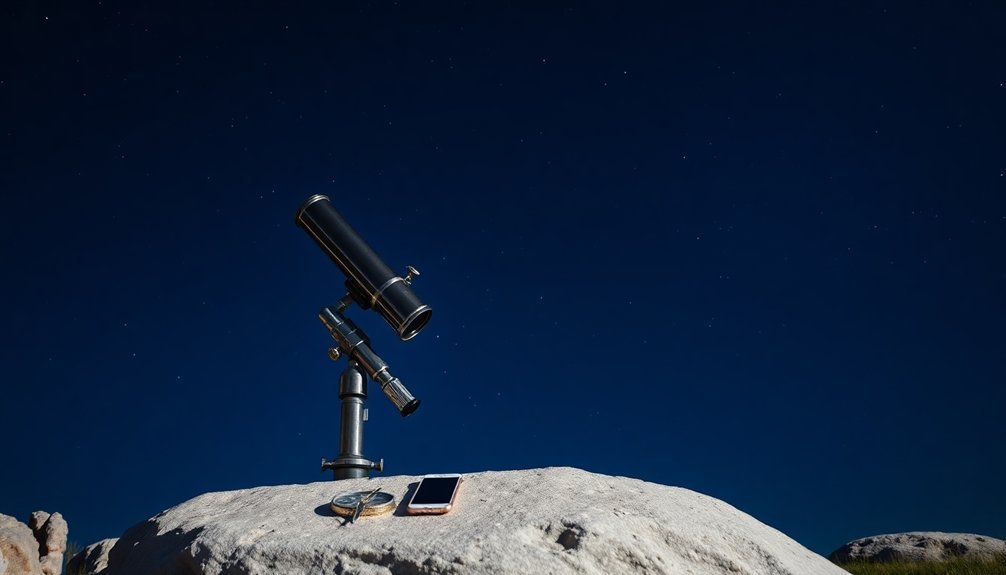
Three key factors separate beginners from experienced astrophotographers: knowledge, practice, and efficient polar alignment. You can master this critical skill in under 10 minutes with the right approach.
Start by leveling your mount and setting it to your location's latitude. For Northern Hemisphere observers, use a polarscope to position Polaris on the correct reticle point. Download Sky-Watcher SyncScan Pro or similar apps to calculate Polaris's exact position.
For quick, precise polar alignment, level your mount, set your latitude, and use polarscope apps to pinpoint Polaris correctly.
Southern Hemisphere observers should use a magnetic compass (adjusted for local declination) for rough alignment to celestial south. When using the polar scope method, look for σ Octantis with its +5.6 magnitude which requires darker skies to identify properly.
For precision, implement drift alignment by tracking star movement and making small adjustments. Alternatively, use astrometric solving software for computer-assisted alignment.
Practice these techniques repeatedly—what initially takes 30 minutes will soon require less than 10.
Master Focus for Tack-Sharp Star Images
With your mount properly aligned, achieving tack-sharp stars becomes your next challenge. Proper focus is arguably the most essential aspect of astrophotography. Most lenses' infinity mark isn't precisely where stars reach maximum sharpness, so you'll need to find your lens's true infinity point through practice.
- Use live view with digital zoom to focus on bright stars or distant lights
- Practice during daylight by focusing on far-away objects to find your lens's true infinity point
- Take test shots and review them at 100% magnification to verify sharpness
- Disable image stabilization when using a tripod as it can actually reduce sharpness
- Consider using focus aids like Bahtinov masks or focus peaking if your camera offers it
After mastering focus techniques, you can further enhance sharpness by using optimal aperture settings between f/2.8 and f/4.0.
Remember that even slight focus errors will greatly reduce the detail in your star images.
Optimal Camera Settings for Tracked Astrophotography

Unlike standard night photography, tracked astrophotography releases the potential for dramatically longer exposures and richer stellar details.
Switch your camera to manual mode and shoot in RAW format to maximize control and image data.
With your star tracker properly aligned, you can extend exposures to several minutes rather than seconds.
Start with ISO 800, adjusting lower for less noise or higher if needed. Open your aperture between f/1.4 and f/4, though stopping down slightly can improve sharpness and reduce aberrations.
For focal length, wide-angle lenses capture broad star fields effectively.
Use an intervalometer to trigger exposures without touching the camera. Using the 10-second delay mode is also effective when you don't have a remote shutter release available.
Set white balance to daylight or auto, and always check your histogram after test shots to verify proper exposure before committing to longer sequences.
Balancing Your Equipment for Stable Tracking
Proper balance sits at the heart of successful star tracking, determining whether you'll capture crisp star fields or suffer from frustrating drift and motor strain. Your tracker performs best when weight is distributed evenly around both the RA and declination axes.
Start by loosening clutches, positioning your setup horizontally, and adjusting counterweights until the system remains stationary when released. Achieving this equilibrium significantly reduces mechanical wear on your equipment while enhancing tracking accuracy.
For ideal tracking performance:
- Position your camera's center of gravity as close to the tracker's rotational axis as possible
- Make small, incremental adjustments rather than dramatic shifts in weight distribution
- Check for dangling cables or loose accessories that might create unexpected torque
- Document successful balance configurations for faster setup next time
- Recheck your balance whenever you change lenses or add equipment
Selecting Ideal Focal Lengths for First-Time Success

Choosing the right focal length stands as one of the most critical decisions you'll make for your first star tracking adventure. As a beginner, aim for focal lengths between 14mm and 24mm to balance field of view with detail.
Wider angles (14mm) will capture more of the night sky but make celestial objects appear smaller, while.24mm offers a more moderate view with larger stars and nebulae.
Remember that crop sensors effectively increase your focal length, requiring adjustments to your exposure calculations. For crop-frame cameras, divide your calculated exposure time by 1.6 for exposure to prevent unwanted star trails.
When calculating exposure times, apply the 500 rule: divide 500 by your focal length to determine maximum seconds before star trails appear. For sharper results with wide lenses, consider using 400 instead.
At 14mm, you'll get about 28 seconds; at 24mm, around 21 seconds.
How to Blend Sky and Foreground Shots Seamlessly
Blending your sky and foreground shots requires attention to both technical precision and artistic vision.
You'll need to master layer masking in Photoshop, using gradient tools to create natural shifts between your tracked sky and static landscape elements.
Proper exposure matching between your images forms the foundation of realistic composites, ensuring your final astrophotography appears as a single cohesive capture rather than an obvious composite. Since typical cameras struggle to capture both bright skies and dark landscapes in one shot, taking and combining two separate exposures allows photographers to achieve a balanced result with proper dynamic range.
Subheading Discussion Points
When you've captured stunning star-filled skies with your tracker and beautiful foreground elements in separate exposures, the critical next step involves combining them into one cohesive image.
The blending process requires careful attention to create natural-looking results where sky meets land. Using RAW format gives you maximum flexibility during post-processing.
- Use luminosity masks in Photoshop to create precise, natural-looking shifts between sky and foreground.
- Verify proper alignment of horizon lines when combining images to avoid awkward shifts.
- Match color temperatures between your sky and foreground shots for consistency.
- Consider light painting techniques during shooting to make blending easier later.
- Start with simple compositions while learning, then progress to more complex scenes as your skills develop.
Be mindful that capturing successful foreground elements often requires bringing extra camera batteries, as recommended for star trail photography where at least one battery per shot is needed.
Layer Masking Techniques
Layer masking represents the powerhouse technique behind creating those jaw-dropping astrophotography images where razor-sharp stars meet perfectly exposed landscapes.
It's your secret weapon for non-destructive editing. The concept is simple: black conceals, white reveals.
When blending tracked sky shots with static foreground images, start with luminosity masks for natural blends. Place your sky image above your foreground and add a mask that hides the lower portion. Working with layer masks ensures you're engaging in non-destructive editing that preserves the integrity of your original images throughout the modification process.
Use gradient tools to create smooth blends between sky and land. For challenging areas like trees or mountains, switch to brush tools with varied opacity.
Remember to check your edges at 100% zoom for seamless integration. For best results, maintain consistent color between shots and organize your layers logically.
This approach preserves detail while creating that magical unified scene.
Exposure Matching Essentials
The perfect astrophotography composite depends on three critical exposure factors working in harmony. When blending tracked sky images with static foreground shots, you'll need to match brightness values, color temperature, and noise levels to create a believable final image.
- Take separate exposures for sky (using your tracker) and foreground (with tracker off)
- Match white balance settings between shots or adjust in post-processing
- Use luminosity masks in Photoshop to create natural-looking shifts
- Expose foreground shots longer at lower ISO to maintain detail without noise
- Shoot in RAW format to maximize exposure adjustment flexibility in post-processing
Consider using apps like PhotoPills or Stellarium to better plan your shooting session and optimize your camera settings for each component of your composite. Remember to conduct test shots before committing to long exposures. A properly executed blend shouldn't reveal where your sky meets your landscape—viewers should simply appreciate the complete scene you've created.
Troubleshooting Common Tracking Errors
Despite your best setup efforts, star tracking errors can frustrate even experienced astrophotographers. When you notice star trails in your images, check for mechanical issues like loose gears or mirror flop first. These common culprits can be fixed with simple maintenance.
Polar alignment errors cause gradual drift that ruins long exposures. Take time to align properly before starting your session. Environmental factors like temperature fluctuations can significantly affect your gear mesh and camera stability during the night.
If you're seeing periodic patterns in star movement, your mount's gears may need correction—most modern mounts offer periodic error correction features.
Don't overlook the basics: verify your cables aren't dragging on moving parts, confirm your mount is properly balanced, and check for any vibration sources.
For persistent problems, try increasing your autoguider exposure time to average out atmospheric seeing effects.
Frequently Asked Questions
How Long Will My Star Tracker's Battery Last in Cold Conditions?
Your star tracker's battery will last particularly shorter in cold conditions. You'll notice reduced runtime as low temperatures slow chemical reactions. Keep it warm and adjust tracking intervals to extend your battery life.
Can I Use Star Trackers for Timelapses or Astro-Landscape Panoramas?
Yes, you can use star trackers for both timelapses and astro-landscape panoramas. They offer intervalometer functions, panorama modes, and tracking capabilities that enhance your night sky photography with longer exposures and smoother motion.
How Much Weight Can Different Star Tracker Models Realistically Support?
You'll find varying capacity: SkyTracker Pro handles 6.6 lbs (best with lenses up to 200mm), while SkyGuider Pro and Star Adventurer support 11 lbs (handling 300-400mm lenses). The LighTrack II carries 13.2 lbs effectively.
Will Star Trackers Work Effectively Near the Celestial Equator?
Yes, star trackers work effectively near the celestial equator. You'll find alignment simpler with the symmetrical sky view, though you'll need digital aids since Polaris won't be visible for reference. Regular calibration remains essential.
Can I Use Star Trackers for Planetary or Lunar Photography?
Yes, you can use star trackers for planetary and lunar photography. They work well with shorter focal lengths up to 500mm, helping you capture sharp details by compensating for Earth's rotation during your exposures.
In Summary
You've now got the essential techniques to start your star tracking journey! Remember, practice makes perfect—you'll improve with each night under the stars. Don't worry about mistakes; they're valuable learning opportunities. Start with simple targets, gradually increase complexity, and soon you'll capture breathtaking deep-sky images that once seemed impossible. Enjoy the process and share your cosmic captures with fellow astrophotography enthusiasts!
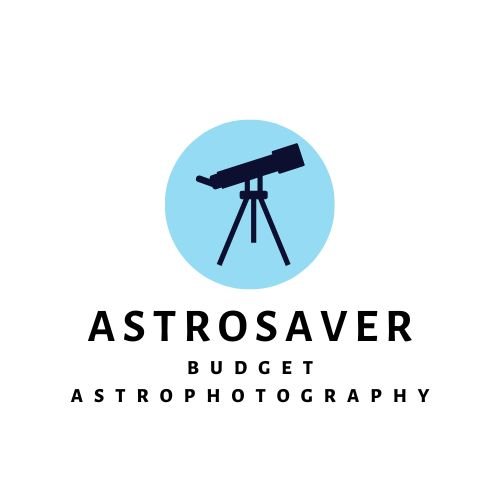
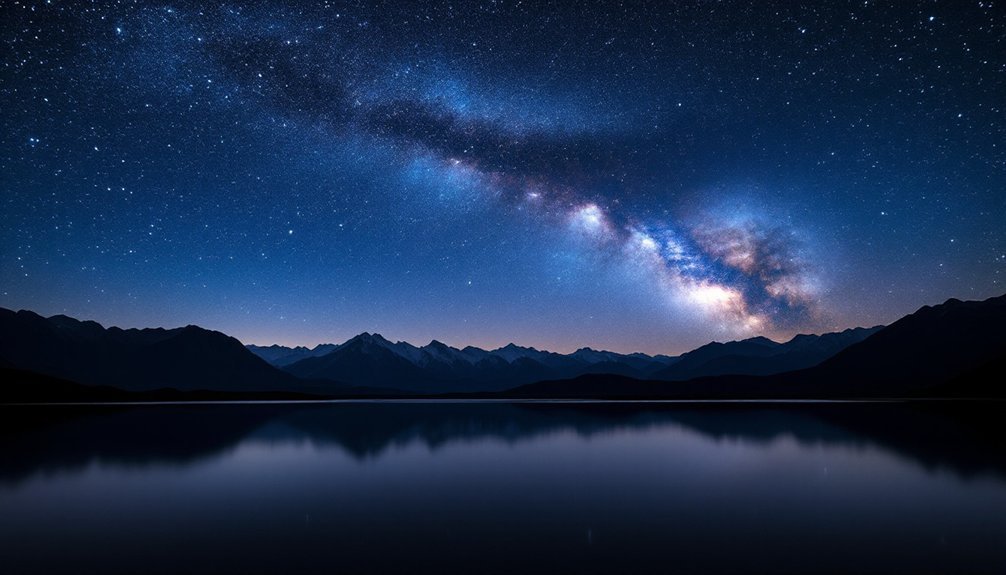
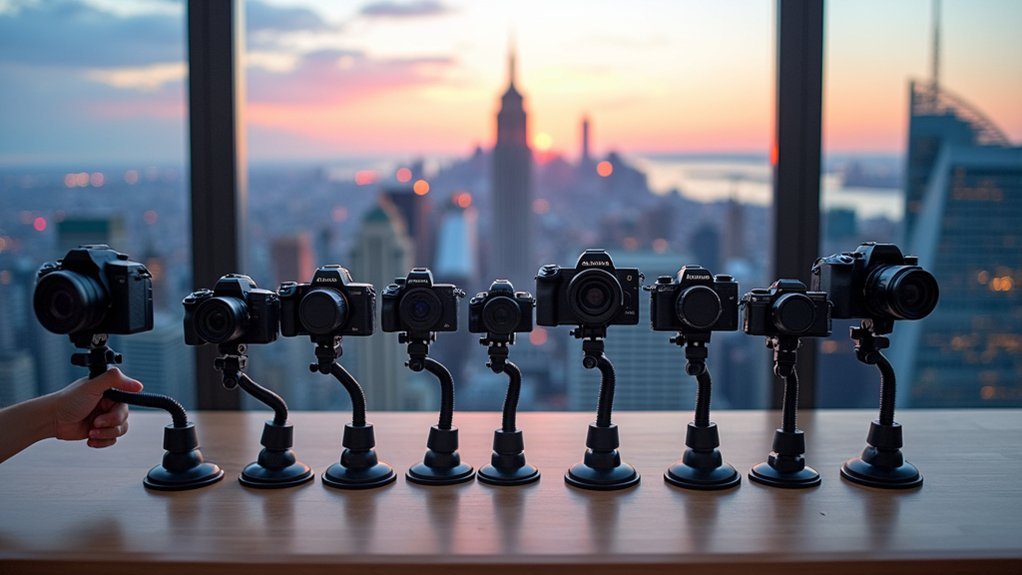
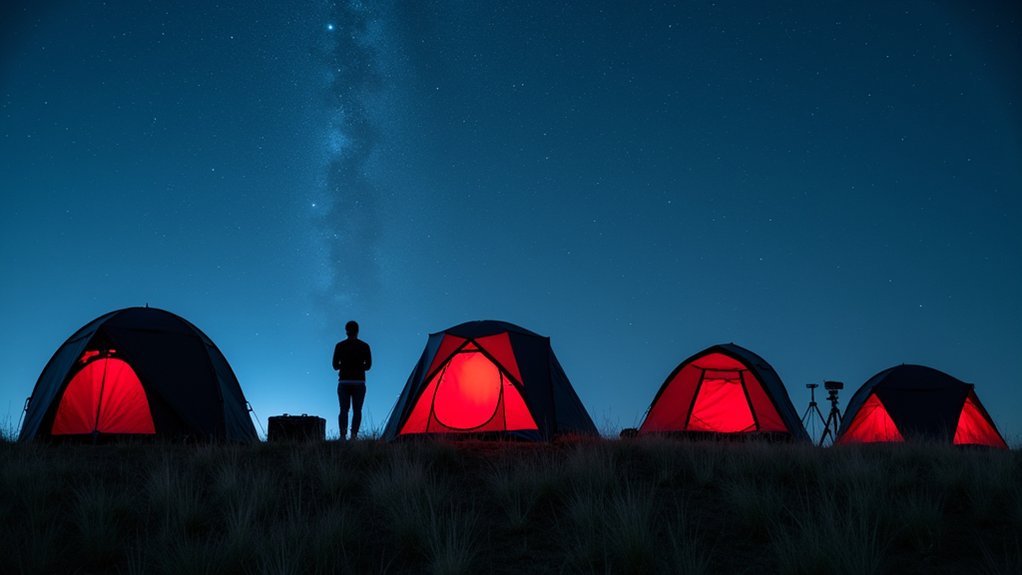
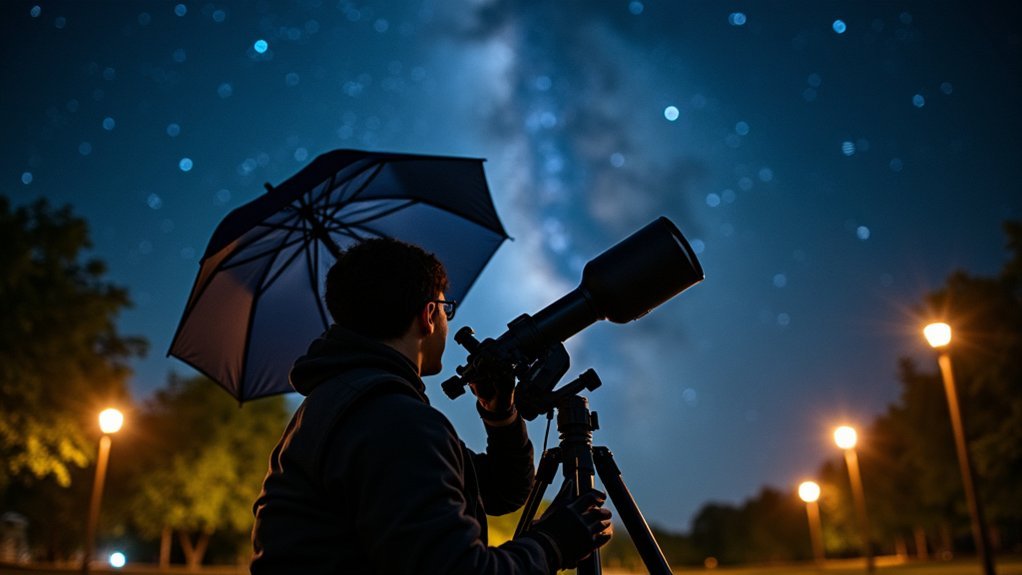
Leave a Reply